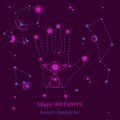Introduction to Nakshatras in Indian Astrology
In the vast and intricate landscape of Indian astrology, Nakshatras hold a place of profound significance. These lunar constellations, also known as star clusters or asterisms, are not just celestial markers but are deeply woven into the very fabric of Indian culture and spirituality. The word Nakshatra itself resonates across India’s many languages and traditions, symbolising the cosmic influences that guide human destiny. From ancient Vedic scriptures to modern-day rituals, Nakshatras are considered essential in determining auspicious timings for major life events—be it marriage, naming ceremonies, or even starting a new venture. Their influence extends beyond astrology; they are intricately linked with daily practices, religious observances, and seasonal festivals. For countless Indians, understanding their birth Nakshatra is more than an astrological curiosity—it is a doorway to self-awareness and connection with the universe. Whether whispered in prayers at dawn or cited by family elders during important decisions, Nakshatras continue to shape the rhythms of Indian life with their timeless wisdom.
2. Classification and Characteristics of 27 Nakshatras
The heart of Indian astrology, or Jyotish Shastra, lies in the intricate system of Nakshatras—27 lunar constellations that hold immense spiritual and practical significance in the lives of millions across Bharat. Each Nakshatra is not just a star cluster but a living archetype with its own personality, mythological deity, unique energy, and influence on the Rashi (zodiac sign) it occupies. Understanding their classifications and characteristics is essential for any genuine astrological analysis as they shape our destinies, behaviour, and even our daily rituals.
Overview of All 27 Nakshatras
Nakshatras are grouped into three broad categories based on their nature: Deva (divine), Manushya (human), and Rakshasa (demonic). Each Nakshatra spans 13°20’ of the zodiac and collectively cover all twelve Rashis. These lunar mansions play a crucial role in determining an individual’s birth chart, Muhurat (auspicious timings), and compatibility in marriage or business partnerships—a tradition followed religiously in Indian households from Chennai to Chandigarh.
| Nakshatra | Ruling Deity | Zodiac Range | Main Qualities |
|---|---|---|---|
| Ashwini | Ashwini Kumars | Aries 0°-13°20’ | Initiation, healing, swiftness |
| Bharani | Yama | Aries 13°20’-26°40’ | Transformation, endurance, discipline |
| Krittika | Agni | Aries 26°40’-Taurus 10°00’ | Courage, purification, sharpness |
| Rohini | Brahma/Prajapati | Taurus 10°-23°20’ | Growth, beauty, fertility |
| Mrigashira | Soma/Chandra | Taurus 23°20’-Gemini 6°40’ | Curiosity, searching mind, exploration |
| Ardra | Rudra (Shiva) | Gemini 6°40’-20°00’ | Intensity, transformation, emotion |
| Punarvasu | Aditi | Gemini 20°-Cancer 3°20’ | Renewal, optimism, nourishment |
| Pushya | Brihaspati (Jupiter) | Cancer 3°20’-16°40’ | Nurturing, wisdom, supportiveness |
| Ashlesha | Nagas (Serpents) | Cancer 16°40’-30°00’ | Mystery, intuition, healing power |
| Magha | Pitris (Ancestors) | Leo 0°-13°20’ | Loyalty, tradition, authority respect |
| Poorva Phalguni | Bhaga (God of Fortune) | Leo 13°20’-26°40’ | Creativity, pleasure, sociability |
| Uttara Phalguni | Aryaman (Sun God) | Leo 26°40’-Virgo 10°00’ | Sincerity, helpfulness, commitment |
| Hasta | Savitar | Virgo 10 ° -23 °20 ’ | Skillfulness , dexterity , adaptability |
| Chitra | Vishwakarma / Tvashtar | Virgo 23 °20 ’-Libra 6 °40 ’ | Creativity , charm , craftsmanship |
| Swati | Vayu (Wind God) | Libra 6 °40 ’-20 °00 ’ | Independence , flexibility , movement |
| Vishakha | Indra & Agni | Libra 20 °-Scorpio 3 °20 ’ | Determination , ambition , duality |
| Anuradha | Mitra (Friendship) | Scorpio 3 °20 ’-16 °40 ’ | Cooperation , devotion , discipline |
| Jyeshtha | Indra | Scorpio 16 °40 ’-30 °00 ’ | Leadership , protection , pride |
| Moola | Nirriti (Goddess of Destruction) | Sagittarius 0 °-13 °20 ’ | Investigation , roots , transformation |
| Purva Ashadha | Apas (Water Goddesses) | Sagittarius 13 °20 ’-26 °40 ’ | Invincibility , optimism , renewal |
| Uttara Ashadha | Vishwadevas (Universal Gods) | Sagittarius 26 °40 ’-Capricorn 10 °00 ’ | |
| Shravana | Vishnu | Capricorn 10 °-23 °20 |
Their Role in Defining Rashi/Zodiac Signs and Daily Life in India
Nakshatras act as the soul of the Rashis—each sign is influenced by multiple Nakshatras which add layers to a person’s Prakriti (nature) beyond mere Sun Sign astrology. In India’s diverse social tapestry—from arranged marriages in Tamil Nadu to baby naming ceremonies in Uttar Pradesh—the selection of auspicious dates is deeply rooted in the transit and placement of Nakshatras. The deities associated with each Nakshatra are invoked for blessings during pujas and festivals throughout Bharat Varsha. Whether you are starting a new venture or celebrating Janmashtami at home, knowing your Nakshatra connects you with ancestral wisdom and cosmic rhythms that have guided Indian life for millennia.

3. Nakshatras and Their Astrological Influence
In the intricate world of Indian astrology, Nakshatras are regarded as the cosmic DNA that weaves the tapestry of a person’s Janam Kundali (birth chart). Each Nakshatra, with its unique mythological story and ruling deity, imprints certain qualities onto an individual at birth. The placement of the Moon in a particular Nakshatra at the time of one’s birth is especially significant, as it shapes not only personality and behaviour but also deeper karmic patterns that unfold throughout life.
The Role of Nakshatras in Janam Kundali
When astrologers analyse a Janam Kundali, one of the first elements they consider is the Nakshatra in which the Moon resides. This placement is called the ‘Janma Nakshatra’ and acts as a blueprint for emotional tendencies, mental strengths, and natural inclinations. For instance, individuals born under Ashwini Nakshatra are often dynamic and pioneering, while those influenced by Rohini may possess charm and creativity. The subtleties of each Nakshatra help astrologers provide personalised guidance that resonates with the lived experiences of people across India.
Shaping Personality and Behaviour
Nakshatras influence how we interact with the world, our approach to relationships, and even our professional choices. The cultural context in India sees these traits being discussed during important events like marriages (Vivah), career decisions, or even selecting auspicious timings (Muhurta) for rituals. For example, natives of Magha Nakshatra are traditionally seen as authoritative and connected to ancestral heritage, making them suitable for leadership roles within family or society.
Karmic Patterns and Life’s Journey
Beyond surface traits, Nakshatras are believed to hold clues about our karmic baggage—lessons carried forward from past lives that shape present circumstances. Many Indian families consult astrologers to understand these deeper influences before major life decisions. By examining planetary periods (Dasha) linked to specific Nakshatras, one can gain insights into challenges or opportunities destined to appear at certain stages of life. This belief strengthens faith in karma and dharma, reinforcing personal growth within the rich spiritual fabric of Indian culture.
Thus, understanding the astrological influence of Nakshatras offers profound self-awareness and helps individuals align their actions with cosmic rhythms—a practice deeply cherished across generations in India.
4. Practical Applications: Marriage, Muhurat, and Remedies
In Indian astrology, Nakshatras are not only a subject of philosophical interest but have deep practical significance in daily life, especially in major milestones like marriage, selecting auspicious timings (muhurat), and prescribing remedies to harmonize planetary influences. The intricate knowledge of Nakshatras empowers astrologers and families to make informed decisions that align with cosmic energies.
Marriage Compatibility (Kundali Milan)
One of the most critical uses of Nakshatras is in match-making, known locally as Kundali Milan or Horoscope Matching. In traditional Indian culture, marriage is considered a sacred union that should be astrologically harmonious. Here, the Janma Nakshatra (birth star) of both the bride and groom is compared using the Ashtakoota system. This system evaluates eight factors to ensure compatibility and harmony. A table summarizing the key Kootas is presented below:
| Koota | Significance |
|---|---|
| Varna | Spiritual compatibility |
| Vashya | Mutual control and attraction |
| Tara | Longevity and health of partners |
| Yoni | Sexual compatibility |
| Graha Maitri | Mental compatibility |
| Gana | Temperament matching |
| Bhakoot | Family welfare and prosperity |
| Nadi | Genetic compatibility and progeny |
If the score obtained in this matching process is high, it is considered auspicious for marriage, ensuring not only marital happiness but also family harmony according to Indian traditions.
Auspicious Timings: Muhurat Selection
Nakshatras play an essential role in muhurat selection – the determination of the most favourable timing for important events such as weddings, housewarming (Griha Pravesh), starting a new business, or even conducting religious rituals. Each Nakshatra has unique qualities; some are considered auspicious for specific activities while others are avoided. For example:
| Nakshatra | Auspicious Activities |
|---|---|
| Punarvasu | Housewarming, travel, education |
| Anuradha | Marriage ceremonies, partnerships |
| Shravana | Learning, spiritual pursuits |
The careful selection of muhurat based on Nakshatra ensures that actions taken during these periods are blessed by positive cosmic vibrations, reflecting the profound belief in “Shubh Muhurat” across India.
Remedies for Negative Effects (Parihara)
No one’s horoscope is free from challenges. Sometimes, certain Nakshatras indicate doshas or negative planetary influences—like Manglik Dosha or unfavorable placement of planets—which can bring obstacles in personal or professional life. Vedic astrology prescribes specific remedies (parihara) tailored to the individual’s Janma Nakshatra. These may include:
- Performing Navagraha Shanti (planetary pacification rituals)
- Daan (charity) on particular days related to one’s Nakshatra lord
- Chanting mantras or stotras associated with specific deities ruling the Nakshatra
- Wearing gemstones after consulting an astrologer for balance and protection
- Observing fasts or participating in temple rituals on Nakshatra birthdays (Nakshatra Jayanti)
This holistic approach reflects the Indian ethos of seeking harmony between individual karma and cosmic order. By understanding and honouring the influence of Nakshatras through marriage matching, muhurat selection, and remedies, Indians continue to weave ancient wisdom into the fabric of modern life.
5. Contemporary Relevance of Nakshatras
In todays rapidly evolving India, the significance of Nakshatras has gracefully transitioned from age-old traditions to become an integral aspect of modern life. While our ancestors relied on Nakshatra analysis primarily for rituals and matchmaking, contemporary Indians are blending this ancient wisdom with their ambitions and daily choices. Many young professionals consult astrologers to understand their birth stars influence before making career shifts or launching startups, believing that auspicious timings aligned with their Nakshatra can help manifest success.
Personal Growth Through Self-Awareness
Nakshatras today are not just about predicting fate—they serve as tools for self-discovery and personal growth. Urban youth increasingly turn to personalized birth chart readings to gain insights into their emotional tendencies, strengths, and challenges. This introspective approach is helping many navigate relationships, mental health struggles, and life transitions more mindfully. By understanding the traits associated with their Nakshatra, individuals strive to harness their innate potential while working consciously on areas that require growth.
Blending Tradition With Modern Aspirations
The blend of tradition and modernity is visible in how families now incorporate Nakshatra guidance into major decisions such as marriage compatibility, buying property, or even choosing a baby’s name. Yet, there is also a pragmatic openness—many Indians use Nakshatra advice alongside scientific reasoning and personal intuition, reflecting an evolving cultural mindset that respects heritage while embracing progress.
A Community Rooted in Heritage
Social media platforms and astrology apps have made Nakshatra analysis accessible to a wider audience than ever before. Forums dedicated to Vedic astrology foster vibrant discussions among tech-savvy millennials who value both spiritual connection and logical inquiry. In this way, the Nakshatras continue to provide a sense of belonging and shared identity across generations, uniting people in the pursuit of both cosmic harmony and individual dreams.
Ultimately, Nakshatras remain deeply woven into the Indian psyche—not as relics of the past but as living guides that help millions navigate the complexities of modern life with purpose and hope.


